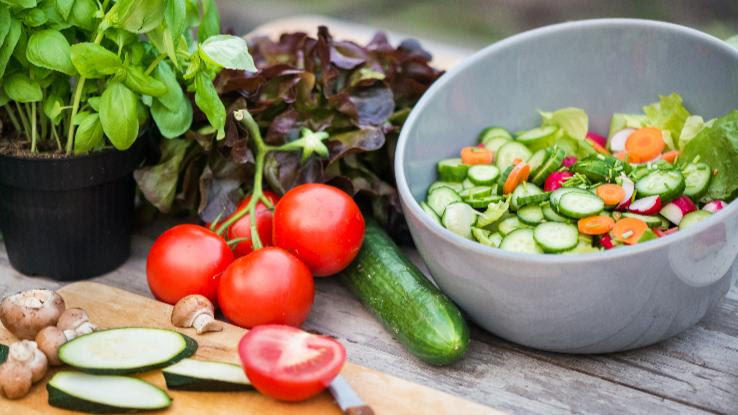
There are plenty of abundant sources of salt in our diets. Open up a cookbook to just about any page, and you’ll probably find that the recipe on it mentions adding a pinch or two of salt for flavor — even if it doesn’t include salt on the ingredients list! And that’s not to mention the salt content of processed and prepared foods we pick up at the grocery store. Table salt is a common ingredient in food, and it’s one of our main sources of sodium. Some Americans eat an average of five or more teaspoons of salt every day, and even if a food doesn’t taste salty, it could still be high in sodium.
While there are benefits to consuming sodium — it helps our nerves and muscles work properly and balances the fluid levels in our bodies — getting too much sodium from your diet can be harmful to your health. Because consuming excess sodium can lead to high blood pressure, heart disease and stroke, many people are opting for low-sodium diets. Your doctor might have even recommended one. These diets can be an adjustment, so it’s important to learn the basics and develop a meal plan. Get started with these tips and food recommendations.
What Are the Benefits of a Low-Sodium Diet?

Salt is often added to food as a preservative and to impart more flavor. Fast foods, convenience or packaged foods, frozen meals, snack foods, and other sweet and salty treats often have high amounts of salt. If you’re looking to cut back on the sodium you consume, it’s best to avoid processed foods. These include:
- Olives
- Pickles
- Anchovies
- Sauerkraut
- Most cheeses
- Chips and crackers
- Most salad dressings
- Soy and Worcestershire sauces
- Packaged tomato and other vegetable juices
- Cured and smoked meats like bacon, hot dogs, sausage, ham, bologna and salami
Limiting the amount of sodium in your food has many benefits, including:
- Reducing dehydration
- Improving your memory
- Lowering your blood pressure
- Lowering your risk of diabetes
- Improving your bones’ structure
- Lowering your risk of headaches
- Decreasing your LDL cholesterol
- Decreasing bloating and swelling
- Lowering the risk of kidney stones
- Preventing the chance of a stroke
- Curbing your craving for salty food
- Preventing congestive heart failure
- Lowering your risk of a heart attack
- Improving and protecting your vision
- Lowering your risk of stomach cancer
- Decreasing your risk of kidney damage
- Decreasing the chance of a brain aneurysm
- Improving your heart’s ability to pump blood effectively
- Reducing the hardening and thickening of your arteries
Cutting back on sodium can improve your health in numerous ways. It’s not always easy to go on a diet, but it can be vital for your well-being. Think of adopting a low-sodium diet as making a long-term lifestyle change that can improve your health in ways you might not imagine.
Tips for Cutting Back on Sodium

On a low-sodium diet, your main goal is to cut back on the salt you consume. You can get started by reducing the amount of salt you add to your everyday cooking. In addition, you can also boost the flavor salt would normally add to food by using flavored vinegar, infused olive oil, herbs, spices and nuts instead. Adding these ingredients can help you get a little more creative with your cooking, too.
Try not to guess at the amount of salt you’re adding to your food. The U.S. Food and Drug Administration (FDA) recommends consuming less than 1 teaspoon of salt per day. While you’re cooking, always measure the salt out in a measuring spoon instead of estimating how much you’re adding. In addition, try using half the amount of salt each recipe recommends.
Another way to cut back on salt? Eat more home-cooked meals instead of ordering food from restaurants. While cooking at home isn’t always convenient, it helps you stay confident about what’s in your food. You know how much salt (if any at all) is in a dish — something you can’t be sure of when you’re heading out of the drive-thru. When you do order restaurant food, ask for less salt. In addition, ask for sauces or dressings to be served on the side; these are common sources of excess salt and sugar.
You’ll also want to stay hydrated throughout the day if you’re eating less salt. A glass of cool water with a lime or lemon slice can quench your thirst and help limit cravings for salty food. This is especially important after exercising, having surgery or recovering from an illness.
Planning Your Low-Sodium Grocery List

Get started with your low-sodium diet by planning your grocery shopping list. While you’re out shopping, check nutrition labels and opt for items with fewer than 400 milligrams of sodium per serving. And, consider this low-sodium grocery list as you get started — you’ll have your kitchen stocked with the essentials in no time:
- Fresh fruits and vegetables, including apples, oranges, bananas, spinach, carrots and broccoli
- Dried beans and peas, including kidney beans, pinto beans, black-eyed peas and split peas
- A variety of seasonings, including herbs, spices, garlic, onions, peppers, lemon and lime juices, and ginger
- Canned vegetables that are low in sodium (be sure to check labels)
- Whole grains, including brown or white rice, quinoa and barley
- Vegetable oils, including canola, corn, olive and peanut
- Chicken or turkey breast without skin or any marinade
- Soy milk with added calcium, vitamin A and vitamin D
- Whole-grain breakfast cereals with no added sugars
- Whole-wheat or whole-grain pasta
- Fat-free or low-fat milk and yogurt
- Low-sodium chips and pretzels
- Whole-grain bread and bagels
- Low-sodium salad dressings
- Lean cuts of beef or pork
- Unsalted nuts and seeds
- Low-sodium cheese
- Fresh or frozen fish
- Unsalted butter
- Eggs
It may take some time for your palate to adjust to new flavors and less salt. But these changes are worth it for improving your health — and even your cooking skills!
Resource Links:
“Guidelines for a Low Sodium Diet | Patient Education,” UCSF Health
“Salt and Sodium | The Nutrition Source,” Harvard TH Chan School of Public Health
“Sodium in Your Diet,” U.S. Food and Drug Administration





